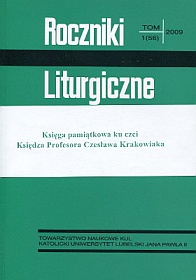Structure and Theology of the Prayer of Consecration of Church and Altar
Abstract
Before a church is ready for liturgical purposes, it should be consecrated by a bishop. In Christian antiquity this rite consisted in bringing in the relics of a saint martyr and saying the first Holy Mass. In later centuries the rites of church’s dedication were enriched by many new elements.
A church, as a visible building, is a special sign of the People of God that is on its pilgrimage on earth and is an image of the community in heaven. Each church that is supposed to be consecrated should have a title. A bishop is the proper steward of the rite of consecration, and the day of consecration is usually Sunday, as then the congregation is more numerous. First there is a solemn prayer of consecration. The introduction to liturgical books confers on it the following meaning: “The Eucharist is the most important and in the only necessary rite of consecration. In line, however, with the common custom of the Eastern and Western Church a special prayer is said that expresses the intention to consecrate the church to the Lord for good and to entreat His blessing” (Ordo dedicationis ecclesiae et altaris II 15). The prayer is therefore the declaration of the will of the whole people announced by the bishop, and it is a request of blessing and sanctification.
It is a new composition that contains two previous consecration prayers, one for the church and one for altar. Thus the inalienable relationship between church and alter is stressed. The editors have shown in it also the classical structure of prayer, poetic power, doctrinal richness, biblical and patristic inspirations. The prayer of consecration expresses the will of the local community that this place become a place where to celebrate holy mysteries, and also mobilize people to contemplation and life in accord with evangelical justice.
Copyright (c) 2009 Liturgical Annals

This work is licensed under a Creative Commons Attribution-NonCommercial-NoDerivatives 4.0 International License.

